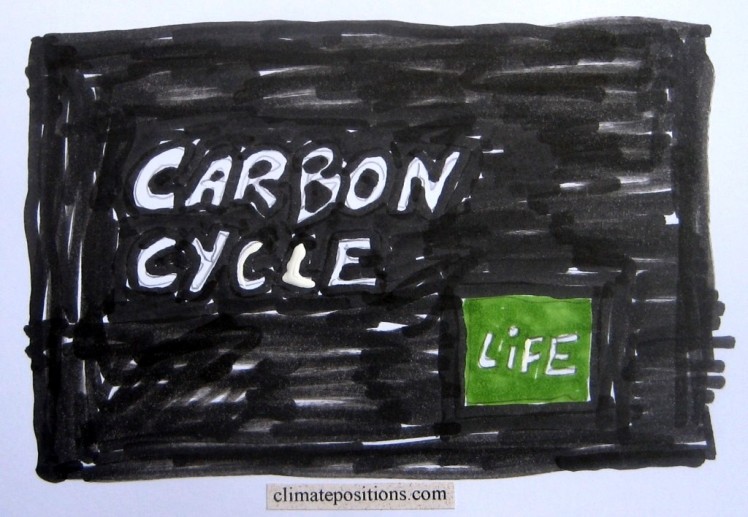Carbon cycle for beginners

2014
Carbon is one out of 118 known chemical elements and symbolized with a “C” (as in CO2). Carbon is globally spread and essential for all life (18.5% of the human body mass is carbon). However, only around 0.003% of the carbon on earth is within living organisms and possibly the double occur in ancient organic deposits of coal, oil, gas and peat. Pure carbon can be chemically composed several ways, for example in the form of diamond, graphite, graphene or simply as amorphous carbon. See this short instructive video: ‘Carbon – Periodic Table of Videos (10:02)’. Carbon forms almost ten million known compounds with other chemical components, which is more than any other chemical element. Carbon dioxide (or CO2) is one compound, composed of one atom of carbon (C) and two atoms of oxygen (O2). Methane (or CH4) is another, composed of one atom of carbon and four atoms of hydrogen.
The carbon cycle is the term for the exchange of carbon among the biosphere (the zone of all ecosystems), the pedosphere (the skin of the earth with all the organisms, soils, water and air), the lithosphere (the hard and rigid outer layer of the earth with broken tectonic plates), the hydrosphere (the water on, under, and over the surface of the earth), and the atmosphere (the layer of gases surrounding the earth). See some of the major carbon reservoirs on earth in the table below.
| Gigaton carbon | |
| . | . |
| Lithosphere | > 75,000,000(?) |
| Oceans and sediments | 38,400 |
| Fossil fuels | 3,880 |
| Terrestrial biosphere | 2,000 |
| Permafrost | 1,550 |
| Atmosphere | 720 |
.
Although the total mass of carbon on earth is huge most of it is stored inactively in the lithosphere (some is frozen in the pedosphere) and the annual exchange among reservoirs is a minor part. Some carbon is released into the atmosphere and the oceans through volcanoes and hotspots. Despite this, the overall carbon exchange balance is stable – apart from the human impact (more below). As an example approximately 122 gigaton of carbon is absorbed annually from the atmosphere by photosynthesis (plants, algae and bacteria) and about the same amount is released by respiration (animals). Oceans contain the largest mass of actively cycled carbon and the surface layer holds large amounts of dissolved organic carbon that is exchanged rather rapidly with the atmosphere. Carbon enters the oceans mainly through the dissolution of atmospheric carbon dioxide or through rivers as dissolved organic carbon. However, around 98% of the oceans’ carbon is stored in the deep layer and the circulation between the two layers is very slow.
The human impact on the carbon cycle is multifaceted and destabilizing on the composition of the atmosphere:
- Fossil fuel with stored carbon is removed and burned to release energy, thus emitting the carbon.
- Production of cement releases stored carbon.
- Deforestation releases carbon and decreases absorption.
- Livestock enteric fermentation and manure management leak methane.
- Rice farming, wetland changes, landfills, etc. leak methane.
- Refrigeration systems emit chlorofluorocarbons (CFCs).
- Fire suppression systems and manufacturing processes emit chlorofluorocarbons (CFCs) and halons.
To put the human impact into perspective the total anthropogenic carbon dioxide emissions from the burning of fossil fuel amounted to around 30 gigaton in 2011 (of which 8 gigaton was pure carbon). When such quantities are emitted for decades it accumulates in the atmosphere and causes global warming. Since the pre-industrial era the amount of carbon dioxide in the atmosphere has increased by 40% and methane (CH4) has increased by 160%. See the development since 1980 ‘here’. Other anthropogenic greenhouse gases without carbon adds to the warming problem. The average global temperature has increased about 0.8°C since 1880 and two-thirds of the warming has occurred since 1975 (see ‘here’).
The urgent question is this: When will feedback loops of melting and ‘darkening ice caps‘, melting permafrost releasing methane, weakened rainforests, coral reefs and other ecosystems, increasing methane leaks from warmed up wetlands, landfills, etc., when will all this accelerate and cause irreversible climate change and dramatic sea level rise?
Next month ‘The Fifth Assessment Report‘ of Intergovernmental Panel on Climate Change (IPPC) will be published..
General information on the carbon cycle is from Wikipedia: ‘carbon cycle’, ‘carbon’, ‘greenhouse gas’, ‘carbon-based life’ and ‘chemical elements’.
Additional information on global warming:
http://earthobservatory.nasa.gov/Features/WorldOfChange/decadaltemp.php
Additional information on greenhouse gases: http://www.esrl.noaa.gov/gmd/aggi/
and (in Danish): http://www.global-klima.org/Kap%202/s2_3c.html#
Glossary (search): http://www.eia.gov/tools/glossary/index.cfm?id=C
The weight of fossil fuels, carbon dioxide emissions and carbon: http://www.eia.gov/tools/faqs/faq.cfm?id=82&t=11 and: http://www.eia.gov/tools/faqs/faq.cfm?id=73&t=11
Drawing by Claus Andersen, 2014.
.
Comments are closed.